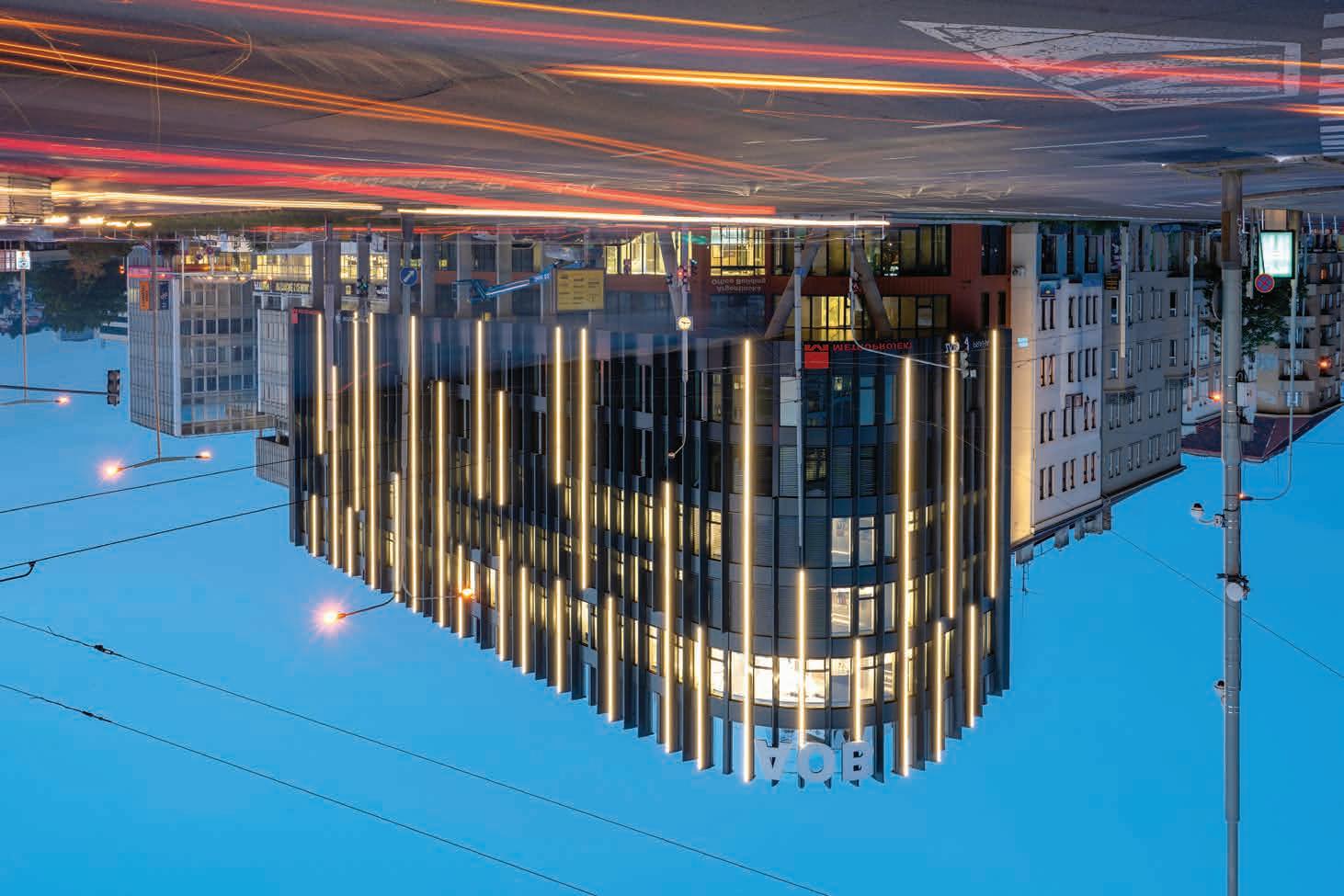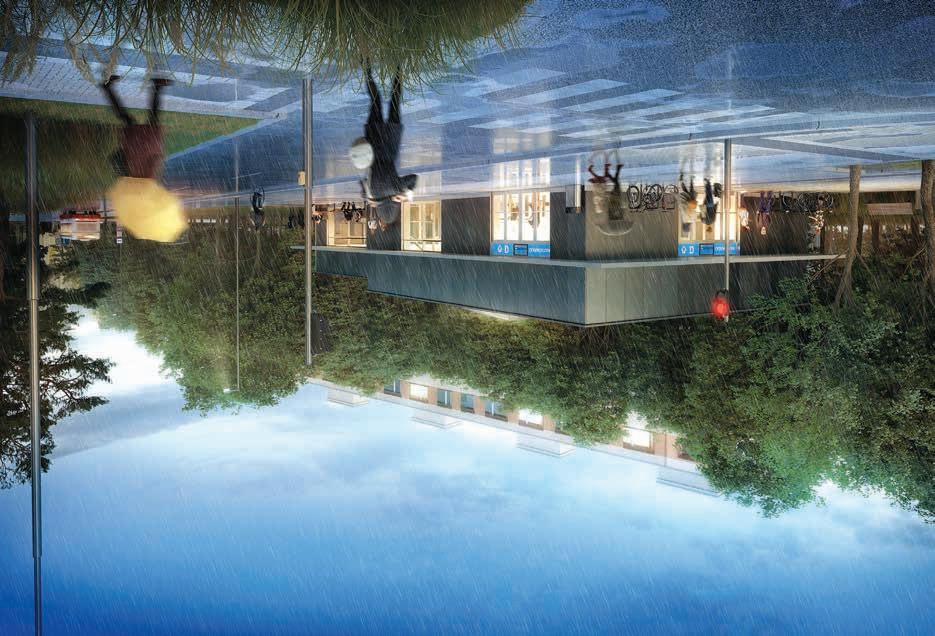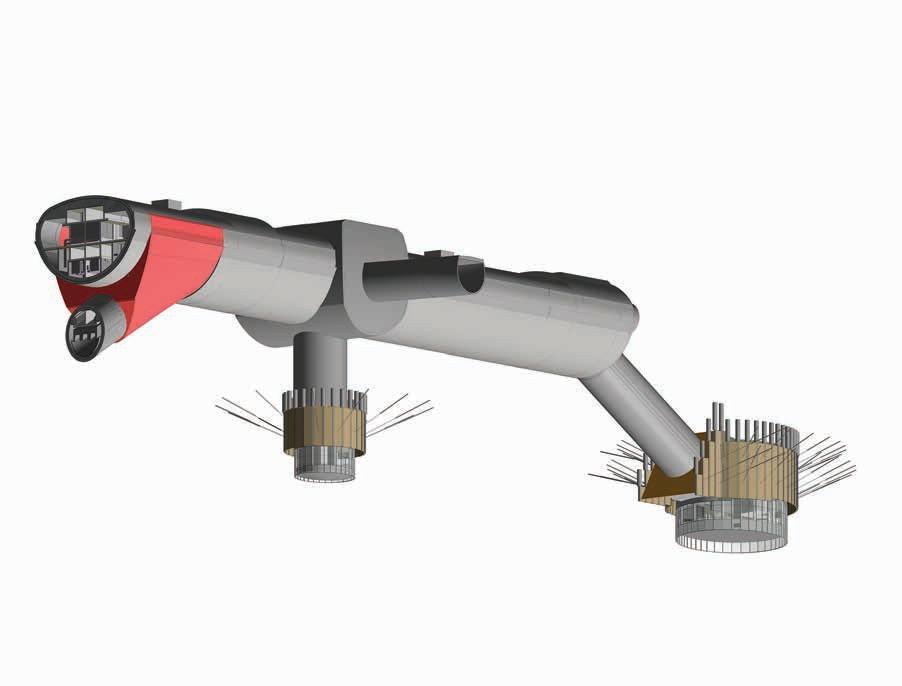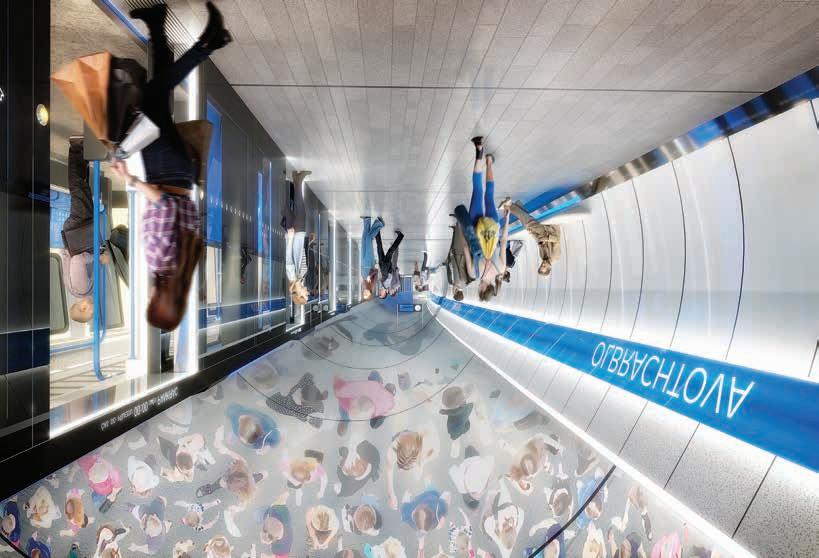
12 minute read
Největší překážkou je alibismus Looking for excuses is the biggest obstacle
Společnost Metroprojekt je svým názvem i historií. neoddělitelně spojena s pražským metrem,. ale spektrum jejích činností je mnohem širší..
Na současné aktivity jsme se zeptali Ing. Davida Krásy, generálního ředitele a předsedy představenstva METROPROJEKT Praha a.s.
Advertisement
Jaký byl rok 2019 pro Metroprojekt a co vás čeká letos? Nedávno skončený rok byl v mnoha ohledech úspěšný. Stále se pohybujeme v prostředí hospodářské konjunktury, veřejní i soukromí investoři stále mají apetit do dalšího rozvoje, velké projekty, na nichž léta pracujeme, se vyvíjejí správným směrem… V létě jsme firmu navíc přestěhovali do nového sídla v Holešovicích. Takže rok 2019 se firmě přiměřeně hospodářsky vydařil a perspektiva do začínajícího roku 2020 vůbec není špatná.
Jednou z nejvýznamnějších připravovaných dopravních staveb je nesporně trasa D pražského metra. Jaké jsou zde poslední novinky? Čtenáři, kteří sledují investiční rozvoj v Praze, jistě zaznamenali přelomovou událost v životě projektu trasy D – začala se stavět! Po devíti letech projektové přípravy, etap střídavě větší a menší politické podpory byla zahájena nultá etapa – geologický průzkum v prostoru Pankráce. V rámci této etapy, jejíž náklady převyšují miliardu korun, probíhá ražba průzkumných šachet a štol, které jsou v poloze budoucích tunelů. Dalším důležitým krokem k realizaci projektu bylo nedávné vyhlášení tendru na dodávku stavby prvního úseku, stanic Pankrác a Olbrachtova a tunelů mezi nimi. Výrazně pokročila i cesta k získání stavebního povolení pro úsek Pankrác – Nové Dvory.
Jak pokračují rekonstrukce stanic na stávajících trasách, popř. výstavba výtahů? V provozované síti pražského metra je 61 stanic a při uvažovaném životním cyklu 30 let je třeba rekonstruovat dvě stanice ročně. Podle našich zkušeností se třicetiletý životní cyklus týká především technologického vybavení (napájení, větrání, eskalátorů, osvětlení, řídicích systémů atd.), téměř nikde nepozorujeme dožívání hlavních nosných konstrukcí. Výjimkou je strop stanice Florenc na prvním úseku pražského metra, otevřeném v roce 1974, kde nyní již v pokročilé fázi připravujeme projekt výměny předpjatých stropních nosníků. Program dostavby bezbariérových výtahů do stanic rovněž pokračuje, často je kombinován právě s rekonstrukcemi celých stanic, jako je Jiřího z Poděbrad, Flora nebo Českomoravská.
Loni na podzim byla – po dlouhých průtazích – vydána územní rozhodnutí pro první dva úseky železničního spojení Praha – Letiště – Kladno. Proč to trvalo tak dlouho? Nastaly v důsledku vypořádání připomínek nějaké změny v projektu? Jak se rýsuje situace s ostatními úseky? Jedná se o dva spíše kratší úseky Praha Bubny – Praha Výstaviště, tedy přes Prahu 7, a Kladno – Kladno Ostrovec, tedy zakončení trasy. Intenzivně jednáme a pracujeme na obstarání územního rozhodnutí pro zbývající úseky, nejblíže na dohled je mimopražský úsek Ruzyně – Kladno. Zbývající části trasy v intravilánu Prahy jsou vázány na změnu pražského územního plánu, která probíhá a měla by být dokončena v tomto roce. Významnou událostí v přípravě tohoto důležitého projektu bylo nedávné dokončení architektonické soutěže na stanici Praha Veleslavín. Těším se na spolupráci s vítězným architektem. V úvodu našeho rozhovoru jsem si aktuální situaci v rozvoji dopravní infrastruktury pochvaloval, ale přes veškerou snahu, proklamace i zákonodárné aktivity se prozatím nedaří urychlit získávání úředních povolení velkých staveb. Největší překážkou nejsou zákony, ale všeobecná opatrnost, často až alibismus, obava z postihu při eventuální chybě v úředním postupu. To tady před 5–10 lety v dnešní míře určitě nebylo.
Podílíte se rovněž na modernizaci IV. tranzitního koridoru. Který úsek je aktuálně ve výstavbě? Co ostatní železniční stavby? Podle naší projektové dokumentace je na začátku realizace úsek trati Soběslav – Doubí u Tábora, což je dvojkolejná trať v kompletně přeložené stopě do blízkosti provozované dálnice D3. Podíleli jsme se rovněž na dílčích částech projektu rozestavěného úseku Sudoměřice – Votice, konkrétně návrhem 600 m dlouhého tunelu Deboreč (pod stejnojmenným kopcem), jehož prorážka nastane v nejbližší době.
Nové sídlo Metroprojektu v Praze 7 New headquarters of Metroprojekt, Prague 7

Jak vypadají přípravy dostavby městského okruhu, který navazuje na tunelový systém Blanka? Jak to říci kulantně? Tunelový komplex Blanka má každodenně mnoho tisíc spokojených uživatelů. Logické by bylo, aby nedlouho po jeho otevření byla slavnostně zahájena výstavba navazujícího a posledního chybějícího úseku Pelc Tyrolka – Štěrboholy. Blanka byla uvedena do provozu v roce 2015, ale výstavba chybějícího úseku nemá konkrétní dohledný okamžik zahájení. Lze říci, že vedení města Prahy před minimálně 10 lety propáslo správné načasování k zahájení přípravy tohoto projektu. Nicméně příprava se již před více než rokem dala do pohybu a naše firma se na ní rovněž podílí. Projekt úspěšně prošel procesem EIA a v loňském roce bylo stabilizováno dopravně-urbanistické řešení, v jehož rámci bylo vedením hlavního města schváleno ještě větší zahloubení trasy okruhu do tunelů pod zem. Jde sice o řešení nákladnější, ale pokud dokáže město Praha najít zdroje k jeho financování, jsem pevně přesvědčen, že další generace si budou toto rozhodnutí jedině pochvalovat.


Jste specialisté na projektování liniových staveb, ale nezaměřujete se pouze na ně. Loni byla dokončena administrativní budova v Argentinské ulici, která pochází z vaší dílny a v níž nyní sídlíte. Plánujete, že se pustíte do něčeho podobného? Máte pravdu, naším živobytím nejsou jen dopravní stavby. Často se nám daří získat projekty, které s dopravou nějak souvisejí. Nyní např. pracujeme na projektech tří parkovacích domů P&R v různých místech Prahy. Nedávno jsme dokončili návrh rekonstrukce zajímavé historické výpravní budovy nádraží v Českých Budějovicích, kde nyní probíhá tendr na dodavatele stavby. Pokračujeme i v projektu, který s dopravou opravdu nijak nesouvisí, revitalizaci pražského Klementina, kde bylo, po úspěšné realizaci první dvou etap, dosaženo shody (pevně věřím) s orgány památkové péče nad návrhem třetí závěrečné etapy.
Budovu v Argentinské jste projektovali v BIM. Uplatní se tato metoda i v dopravních stavbách? Já mám z nového sídla naší firmy v Argentinská Office Building upřímnou radost. Moderní prostředí oceňuje naprostá většina jak klientů a partnerů, tak zaměstnanců. A rovněž mám radost z toho, jak jsme si z realizační projektové dokumentace a průběhu výstavby objektu udělali takovou naši laboratoř BIM. Ale k vaší otázce – samotná zkratka BIM implikuje, že se jedná o budovy – Building Information Modeling. Pro ně byla celá metoda prvotně vyvinuta včetně softwarových a dalších prostředků a projekty budov jsou v nasazení BIM jednoznačně nejdál. V dopravních stavbách s BIM všichni začínáme, naše firma i celá skupina SUDOP Group, do níž Metroprojekt patří, se intenzivně snaží být na špičce tohoto vývoje a investuje do něj nemalé prostředky. Ve srovnání se stavem BIM v projektech budov lze však nyní naší situaci přirovnat spíše k jednookému mezi slepými.
PR
Metroprojekt is, with its name and history,. inseparably connected with Prague’s. underground but the spectre of their. activities is much broader..
We asked Ing. David Krása, a Managing Director and Chairman of the Board at METROPROJEKT Praha a.s., about their current activities.
What was 2019 like for Metroprojekt and what do you expect this year? The recently completed year was successful in many ways. We still find ourselves in the environment of an economic boom, public and private investors still have the appetite for further development and large projects that we have been working on for years are heading in the right direction… Moreover, in the summer, we relocated our company to new headquarters in Holešovice. So, 2019 was relatively successful for the company from an economic point of view and the perspective for 2020 does not look bad at all.
One of the most significant of the prepared road structures is no doubt the D underground route in Prague. What is the latest news from there? The readers who follow investment development in Prague have, no doubt, registered the turning point in the D route project’s life – it was actually commenced! After nine years of project preparation, stages of alternately changing bigger or smaller political support, the zero stage of the project, that is the geological survey in Pankrác area, was commenced. This stage, whose costs exceeds a billion of Czech crowns, includes the driving of shafts and tunnels, which are in the position of future tunnels. Another step that is important for the realization of the project was the recent tender announcement for the contractor of the construction of the first section, the Pankrác and Olbrachtova Stations and the tunnels between them. The process of the acquiring a building permit of the Pankrác – Nové Dvory section has also progressed significantly.
How does the reconstruction of the stations situated on the existing routes proceed, for instance construction of lifts? The operated network of Prague’s underground includes 61 stations and with the anticipated life-cycle of 30 years,

it is necessary to reconstruct two stations a year. Based on our experience, the thirty-year cycle mainly refers to technical equipment (power supply, venting, escalators, lighting, control systems, etc.), for we don’t see the main load-bearing structures to be at the end of their life-cycle almost anywhere. The exception is in the ceiling of the Florenc station in the first section of Prague’s underground opened in 1974, where we are now preparing a project of replacement of ceiling girders, this being in an advanced phase. The programme of the completion of disabled friendly lifts for the station also continues to proceed and is often combined with the reconstruction of the whole station, such as Jiřího z Poděbrad, Flora and Českomoravská.
Planning permits for the first two sections of the railway connection Prague – Airport – Kladno was issued last autumn after a long delay. Why did it take so long? Did the process of settling objections result in some alterations in the project? How is the situation with other sections? It is rather about two shorter sections, Prague Bubny –Prague Výstaviště through Prague 7, and Kladno – Kladno Vizualizace stanice Olbrachtova na trase D Visualization of Olbrachtova station, route D

BIM model stanice Nové Dvory, trasa D BIM model of station Nové Dvory, route D
Ostrovec at the end of the route. We negotiate intensively and work on the acquiring of a planning permit for the remaining sections with the closest to finish being the Ruzyně – Kladno section outside Prague. The remaining parts of the route within Prague’s built-up area are subject to the change of Prague’s outline plan, which is proceeding at the moment and which should be completed this year. A significant event that occurred in the preparation of this important project was the recent completion of the architectural tender for Prague Veleslavín station. I look forward to co-operation with the winning architect. In the opening of our interview, I was praising the current situation in the development of transport infrastructure but, despite all efforts, proclamations and legislative activities,
the speeding up of the process of acquiring permits for large constructions is not successful just yet. The biggest obstacle does not lie in laws but in general carefulness, often even in looking for excuses, fear from a penalty in case of making a mistake in the official process. This certainly did not happen to this extent here 5–10 years ago.

You also participate on the modernization of the 4 th railway transit corridor. Which section is currently under construction? What about the other railway constructions? According to our project documentation, the project that is now being commenced is the realization of the Soběslav – Doubí by Tábor railway line section, a two-track railway line in a completely relocated track within the vicinity of the D3 motorway. We also participated on partial sections of the project of Sudoměřice – Votice, which is currently under construction, in particular with the design of a 600 m long tunnel Deboreč (under a hill of the same name), which will be driven in near future.
What is the situation regarding the preparation of the completion of the city ring road, which connects onto the Blanka tunnel system? How to say this tactfully… The tunnel complex Blanka has many thousands of satisfied users daily. What would be logical would be to commence the construction of the connecting and last remaining section, the section of Pelc Tyrolka – Štěrboholy, soon after the completion of Blanka. Blanka was put into operation in 2015 but the construction of the remaining section has no particular date for commencement. One can say that Prague council missed the right timing for the commencement of this project at least 10 years ago. Nevertheless, the preparation was put into motion more than a year ago and our company also participates in it. The project underwent the EIA process successfully and the transport-urban solution, within whose framework the Prague council also approved deeper embedding of the route through tunnels underground, was stabilised last year. It is more costly but if Prague can find resources to finance it, I am convinced that future generations will only praise this decision.
You specialize in designing linear structures, but you don’t only focus on those. The administrative building in Argentinská Street, which comes from your workroom and where you are now based, was completed last year. Are you planning to get into something similar? You are right. We don’t only attend to road structures. We often manage to get projects that are not associated with transportation in any way. Now we are, for instance, working on projects of three P&R parking buildings in different parts of Prague. Recently, we have completed the proposal for the reconstruction of an interesting historical station building in České Budějovice, where they now hold a tender for the contractor. We also continue with a project that really has nothing to do with transportation and that is the revitalization of Klementinum, Prague, where we, after a successful realization of the first two stages, came to an agreement (so I believe) between ourselves and historical preservation authorities about the proposal of the third and final stage.
The building in Argentinská was designed in BIM. Can this method also be used in road structures? I am really pleased with our new headquarters in Argentinská Office Building. The majority of our clients, partners and employees appreciate the modern environment. And I am also pleased how we turned the realization project documentation and the process of the construction of the building into some sort of BIM laboratory. Back to your question, though – the abbreviation BIM alone implies that it refers to buildings – Building Information Modeling. The method was primarily developed for them, including software and other tools and resources and the projects of buildings executed in BIM are clearly most advanced. As for the road structures, we all, our company as well as the whole SUDOP Group, to which Metroprojekt belongs, are only starting with BIM there and are intensively trying to be at the very top of this development, also investing considerable resources in it. Compared with BIM in projects of buildings, our situation can rather be likened to the one-eyed amongst the blind.
PR










